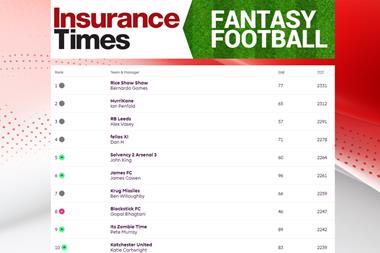The unlikely collaboration between actuaries and marketing teams is the only profitable way forward for insurers in an aggregator-led market
It may seem about as likely as Wayne Rooney playing cricket for England, but insurance marketeers and actuaries have started working in close collaboration in the new distribution scene dominated by aggregators.
When it comes to breaking down functional silos, the idea of such teamwork sounds about as extreme as it gets. Yet developments in distribution and marketing means co-operation is becoming increasingly important and widespread.
Although this radical trend pre-dates today’s high usage of internet price comparison websites, the rise of the aggregator has given it an extra urgency. The UK market for private motor insurance – if not yet for home insurance – is fast approaching what economists would describe as ‘perfect’. But while it may be perfect for consumers, it is decidedly tricky for personal lines insurers, which makes it all the more essential to understand the buying patterns and profit potential of individual consumers.
That is why marketing in its fullest sense is so important: the management process of identifying potential customers, creating products that will appeal at sustainable prices and then communicating this to customers in a well-targeted, persuasive and cost-effective manner.
It is hard to imagine a more vital function in lines such as motor, where the aggregators are making it almost impossible to achieve a profit from pure underwriting.
The creative image of marketing teams hides the fact that many of them apply an impressive range of analytical techniques to their work to gain an accurate and detailed understanding of their markets and to predict buying patterns, often at the individual customer level.
Furthermore, being so rich in data, personal lines insurance has the potential to be a marketeer’s dream if all this data can be marshalled and deployed effectively to deliver additional revenues. It is no surprise, therefore, that many leading insurers are beefing up their marketing expertise by recruiting top people from the fast-moving consumer goods sector.
Perfect match
Despite some overlap in techniques, actuaries have a different set of analytical skills. When it comes to optimising the trade-off between profit margins and volume, the actuary is very much in home territory. Similarly, while the marketing person may have tremendous experience of exploiting behavioural data held in customer relationship management systems, his or her actuarial colleagues will be much more familiar with loss cost and variability information. So it makes absolute sense to join the two together.
In the traditional business model, the actuary leads decisions about pricing to profit targets, while the marketing person champions sales performance and the brand. Rarely do their paths cross. This silo approach can quite easily harm the business, introducing inefficiencies and missed opportunities, such as:
• The pricing process overlooking customer data held by the marketing department, potentially leaving profit on the table, losing customers unnecessarily or missing cross-sell opportunities.
• Marketing ignoring pricing and underwriting risk metrics, potentially generating low response enquiries or spending money attracting and retaining low-value customers
• Inconsistent definition of key performance metrics, especially around sales volumes and customer value, leading to conflicting behaviours.
• The potential for double discounting in the price offered to target customer groups, and for “undoing” sophisticated optimised pricing.
The aggregator challenge
Let’s now take a closer look at the task of selling insurance through aggregators, a channel that is already becoming dominant in motor and steadily increasing its foothold in household. Since there are always underwriters who underprice their products, either by accident or design, the most competitive offering in any segment is likely to be loss-making. In this way, aggregators threaten to have insurers in an unprofitable stranglehold.
Yet the view that price is king is an over-simplification of the aggregator world. Our research has found that more than two thirds of motor insurance consumers take other factors into consideration. Strong brands outperform weak ones by a factor of at least two when it comes to converting quotes into sales. It is often sufficient for a trusted brand to be in the best three in terms of price to generate acceptable volumes of business through aggregators.
In these circumstances, being able to quantify the impact of brand on conversion rates at different aggregator screen rank positions is a critical task in ensuring optimal pricing levels and targeting of customers. And it is one where actuarial skills, such as measuring price elasticity and loss costs, are most effective when combined with brand measurement and other skills associated with marketing teams.
Even accurate underwriting is not enough on its own. Our analysis showed that all the top 20 motor insurers suffered combined ratios of more than 100% in 2008 (see Insurance Times, 2 July 2009). There is a growing recognition that if insurers are to make a profit on aggregator business, it has to come from ancillary income streams, upselling, or cross-selling add-ons
such as legal expenses or breakdown cover. Critical success factors include achieving price competitiveness of the core cover, understanding add-on purchase propensities, website presentation and call-centre scripting, and value-targeted outbounding. These are all areas where marketing staff and actuaries are most likely to deliver results by working as a team.
A fresh approach
It goes without saying that there needs to be a new way of thinking all round, based on an appreciation that different types of expertise can deliver synergistic performance benefits.
It also requires a new approach to data sharing, Is the pricing team, for example, using all the data assets available to the organisation, particularly those from customer relationship management systems or external sources? Has the marketing team deployed relevant risk and pricing metrics in its segmentation to support activity around, for example, renewal incentives?
And just how important is it to take this kind of co-operative action? Aggregators have transformed the rules of motor underwriting.
The ability to identify segments where it is possible to win business without destroying profit margins could make all the difference between success and failure. IT
Stephen Jones is a director at EMB and a specialist in developing aggregator strategy for insurers and intermediaries





































